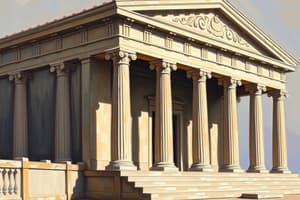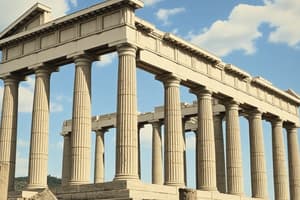Podcast
Questions and Answers
What is an entablature?
What is an entablature?
- A horizontal, continuous lintel on a classical building (correct)
- A rectangular column
- A broad horizontal band of decoration
- The top of a column
What is a frieze?
What is a frieze?
A broad horizontal band of sculpted or painted decoration
What is an architrave?
What is an architrave?
A plain, unornamented lintel on the entablature
Abacus + Echinus = ____
Abacus + Echinus = ____
What does the term 'capital' refer to in columns?
What does the term 'capital' refer to in columns?
Define stylobate.
Define stylobate.
Which three are the main Greek orders of architecture?
Which three are the main Greek orders of architecture?
What characterizes the Doric column?
What characterizes the Doric column?
What is unique about the Ionic column?
What is unique about the Ionic column?
What differentiates the Corinthian column?
What differentiates the Corinthian column?
What is the shaft of a column?
What is the shaft of a column?
What is the purpose of triglyphs?
What is the purpose of triglyphs?
Define entasis.
Define entasis.
What does fluting refer to in the context of columns?
What does fluting refer to in the context of columns?
What is a balustrade?
What is a balustrade?
What is a parapet?
What is a parapet?
Flashcards are hidden until you start studying
Study Notes
Column Structure and Components
- Entablature: A horizontal lintel in classical architecture supported by columns or walls, composed of the architrave, frieze, and cornice.
- Frieze: A decorative horizontal band, often sculpted or painted, located near the ceiling.
- Architrave: The unadorned lower section of the entablature that directly rests on the capitals of columns.
- Abacus: The flat slab at the top of a capital, providing a base for the architrave.
- Echinus: The convex part of a capital located beneath the abacus, contributing to the overall shape of the capital.
Capital and Column Types
- Capital: The top element of a column or pilaster, comprising the abacus and echinus.
- Stylobate: The continuous base that supports a series of columns in classical Greek architecture.
- Doric Column: The oldest Greek order, known for its sturdy fluted design, plain capitals, and lack of a base; symbolizes strength.
- Ionic Column: Recognized for its scroll-shaped capitals (volutes), this column has a rounded base and delicate fluting, often thought of as more feminine.
- Corinthian Column: The most ornate order featuring capitals with elaborate leaf motifs. It is characterized by a taller and more slender design with a base similar to the Ionic style.
Architectural Details
- Metope: The square area between triglyphs in a Doric frieze, often used for decorative reliefs.
- Triglyph: A three-grooved, projecting element of a Doric frieze that alternates with metopes.
- Entasis: A subtle curvature in a column's shaft designed to combat the visual illusion of concavity in straight columns.
- Volute: The decorative scroll-like element found on Ionic capitals, resembling a curled scroll.
- Fluting: Vertical concave grooves running along the shaft of a column, enhancing its aesthetic appeal.
Supporting Structures and Features
- Balustrade: A protective railing along balconies or staircases to prevent falls.
- Parapet: A low wall or railing atop a structure such as a balcony, providing safety.
- Pilaster: A rectangular column that serves as a decorative element on walls, projecting outward.
Key Orders of Greek Architecture
- Three Main Orders: Doric, Ionic, and Corinthian represent the evolution of Greek architectural styles, each with unique characteristics reflecting different aesthetic values.
Studying That Suits You
Use AI to generate personalized quizzes and flashcards to suit your learning preferences.




